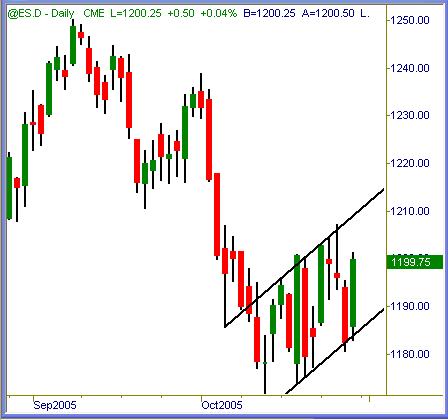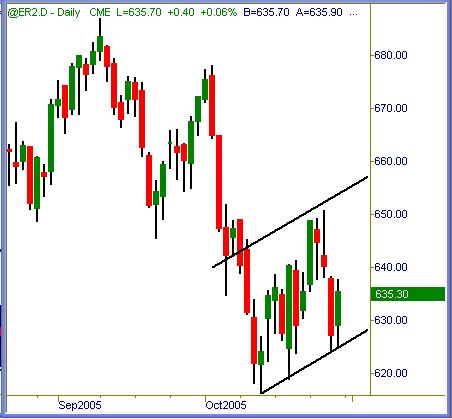Find better setups in the Russell, here’s how
“Trendless On Wall Street” would be the
title of this market if it were a movie. One day’s decline leads to a following
day’s rally, which leads to a sell-off the next day. Ramp, rinse, repeat.
Definitely a trader’s market right now, with a return to normal price ranges and
volatility firmly entrenched to stay.
ES (+$50 per index point)
S&P 500 continues to bounce inside the clearly
established ascending channel = potential bear flag pattern. Friday’s end-month
action was expected to be upside by day’s end, and did not disappoint. The ES
offered four distinct trade signals that went for more than +5pts apiece… one
short and three longs. Picking off one or two of those inside the cash market
session is all a trader needs to do for methodical success to happen!

ER (+$100 per index point)
Russell 2000 posted an inside session Friday,
albeit erasure of Thursday’s decline. Price action remains pinned inside the
ascending channels in perfectly sideways fashion. Is this basing action at a
relative bottom or the pause that refreshes before a continued plunge? An equal
number of traders in both camps essentially keep the sideways pattern in place.

This Session
Last day of the calendar month precedes the next FOMC event. A lot of times
during the actual end-month session a late afternoon sell-off begins as hedge
funds try to get in front of mutual fund window undressing soon to come. Even
the first day of calendar months have potential to rally as new money flows in,
so early weakness may reverse upside while early upside on gap & go moves that
flatten sideways midday are prone to closing bell corrections lower. When 2:15pm
EST on FOMC day arrives, we could see a pretty big swing from there into its
closing bell.
ER’s Evolution
Roughly two years ago, volatility and intraday ranges shrank continually. In
that time, momentum traders shifted from stocks and other instruments into the
S&P. Not only were intraday ranges contracting, the sideways swings accentuated.
Buzz and fuzz, fuzz and buzz became the norm between actual price moves.
Meanwhile, the Russell 2000 was relatively
undiscovered. Volume was thin, probably akin to the S&P 400 midcaps today. While
the 2pt scalper ES traders were busy beating their brains out inside shriveling
tapes, the ER still made very methodical swings upward and down. Trading the
Russell made sense in every aspect, it was much easier and twice as profitable
compared to the ES back then. Part of that was due to a lack of program trading:
liquidity in the small-cap stocks and ishares prevented the program slam
movement rife in ES and NQ symbols.
Flash forward two years, and things have
changed. The volume in ER minis has increased several hundred percent. The
Russell 2000 index ishare has become a very popular trading vehicle, and program
trading is a big part of the tape. Intraday ranges and potential profits trading
ER versus ES continue to be nearly twice as wide. However, the ER has gone from
being a methodical symbol to trading rather fast & loose. We commonly see
slippage of two and even three ticks between trade fills. Why? More block
traders now than before, without enough open interest available to handle the
volume.
Secondly, the evolution from methodical
movement to spiky action means trade signals likewise go from methodical to
spiky. The ER still hits a same number of trade signals per day as it ever did
before. However, many times those entry signals happen in a flash… tapping the
entry zone on a spike or dip before pinging off that mark in a nanosecond.
Setting limit orders to enter = exit does not
solve the problem. Many times a limit order will be partially filled at best, or
unfilled completely. Try sitting on an open five-lot or ten-lot ER position with
stop-limit exit in place and have price action go against your trade while
taking out half the contracts on that limit. Guess what? The other half of your
trade is still live while price action is moving against you. Think fast…
watcha gonna do while they come for you?
For sure the ER remains tradable. Equally sure
is the fact that it is no longer a gentle trend while ES gyrates wildly. These
days the ER is in my opinion tougher to trade than the ES. Entry signals flash
quicker than ES, which means ER traders must be more responsive and decisive.
Also, slippage has become more pronounced in my live trading experience than
ever before. What used to be the kinder, gentler symbol is now a wild child
compared to the ES.
If you are having acceptable to excellent
results while trading the ER, by all means keep up the good work! On the other
hand, if you find it a bit fast for catching the entry signals, exits and
holding stops, strongly consider focusing on the ES instead. Both are tradable,
each offers plenty of profit potential each week!
Summation
The FOMC event will dominate conversation and trader thoughts from
here. After that, back to the usual econ reports for next excuse(s) to jerk the
tapes. Until visible channel ranges are broken, expect price action to remain
contained. If those channels break downside, expect considerable distance lower
to be covered post-haste from there.
Trade To Win
Austin P
(Weekend Outlook trend-view section…
free access)
Austin Passamonte is a full-time
professional trader who specializes in E-mini stock index futures, equity
options and commodity markets.
Mr. Passamonte’s trading approach uses proprietary chart patterns found on an
intraday basis. Austin trades privately in the Finger Lakes region of New York.
